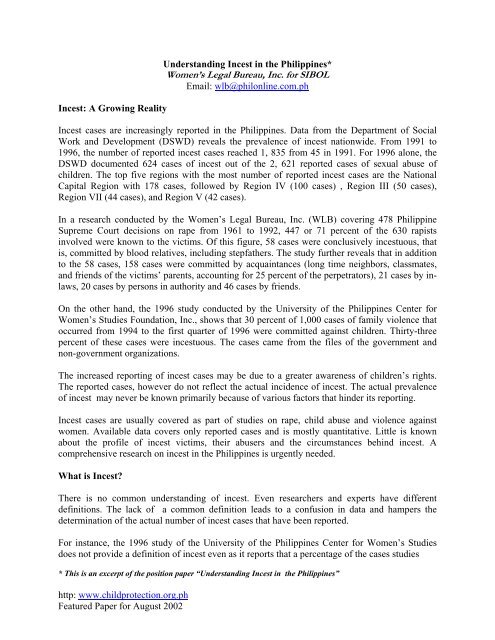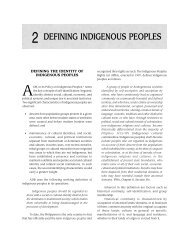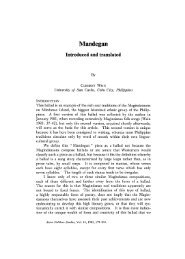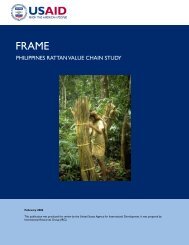Understanding Incest in the Philippines* - Philippine Children
Understanding Incest in the Philippines* - Philippine Children
Understanding Incest in the Philippines* - Philippine Children
- No tags were found...
You also want an ePaper? Increase the reach of your titles
YUMPU automatically turns print PDFs into web optimized ePapers that Google loves.
<strong>Incest</strong>: A Grow<strong>in</strong>g Reality<strong>Understand<strong>in</strong>g</strong> <strong>Incest</strong> <strong>in</strong> <strong>the</strong> Philipp<strong>in</strong>es*Women’s Legal Bureau, Inc. for SIBOLEmail: wlb@philonl<strong>in</strong>e.com.ph<strong>Incest</strong> cases are <strong>in</strong>creas<strong>in</strong>gly reported <strong>in</strong> <strong>the</strong> Philipp<strong>in</strong>es. Data from <strong>the</strong> Department of SocialWork and Development (DSWD) reveals <strong>the</strong> prevalence of <strong>in</strong>cest nationwide. From 1991 to1996, <strong>the</strong> number of reported <strong>in</strong>cest cases reached 1, 835 from 45 <strong>in</strong> 1991. For 1996 alone, <strong>the</strong>DSWD documented 624 cases of <strong>in</strong>cest out of <strong>the</strong> 2, 621 reported cases of sexual abuse ofchildren. The top five regions with <strong>the</strong> most number of reported <strong>in</strong>cest cases are <strong>the</strong> NationalCapital Region with 178 cases, followed by Region IV (100 cases) , Region III (50 cases),Region VII (44 cases), and Region V (42 cases).In a research conducted by <strong>the</strong> Women’s Legal Bureau, Inc. (WLB) cover<strong>in</strong>g 478 Philipp<strong>in</strong>eSupreme Court decisions on rape from 1961 to 1992, 447 or 71 percent of <strong>the</strong> 630 rapists<strong>in</strong>volved were known to <strong>the</strong> victims. Of this figure, 58 cases were conclusively <strong>in</strong>cestuous, thatis, committed by blood relatives, <strong>in</strong>clud<strong>in</strong>g stepfa<strong>the</strong>rs. The study fur<strong>the</strong>r reveals that <strong>in</strong> additionto <strong>the</strong> 58 cases, 158 cases were committed by acqua<strong>in</strong>tances (long time neighbors, classmates,and friends of <strong>the</strong> victims’ parents, account<strong>in</strong>g for 25 percent of <strong>the</strong> perpetrators), 21 cases by <strong>in</strong>laws,20 cases by persons <strong>in</strong> authority and 46 cases by friends.On <strong>the</strong> o<strong>the</strong>r hand, <strong>the</strong> 1996 study conducted by <strong>the</strong> University of <strong>the</strong> Philipp<strong>in</strong>es Center forWomen’s Studies Foundation, Inc., shows that 30 percent of 1,000 cases of family violence thatoccurred from 1994 to <strong>the</strong> first quarter of 1996 were committed aga<strong>in</strong>st children. Thirty-threepercent of <strong>the</strong>se cases were <strong>in</strong>cestuous. The cases came from <strong>the</strong> files of <strong>the</strong> government andnon-government organizations.The <strong>in</strong>creased report<strong>in</strong>g of <strong>in</strong>cest cases may be due to a greater awareness of children’s rights.The reported cases, however do not reflect <strong>the</strong> actual <strong>in</strong>cidence of <strong>in</strong>cest. The actual prevalenceof <strong>in</strong>cest may never be known primarily because of various factors that h<strong>in</strong>der its report<strong>in</strong>g.<strong>Incest</strong> cases are usually covered as part of studies on rape, child abuse and violence aga<strong>in</strong>stwomen. Available data covers only reported cases and is mostly quantitative. Little is knownabout <strong>the</strong> profile of <strong>in</strong>cest victims, <strong>the</strong>ir abusers and <strong>the</strong> circumstances beh<strong>in</strong>d <strong>in</strong>cest. Acomprehensive research on <strong>in</strong>cest <strong>in</strong> <strong>the</strong> Philipp<strong>in</strong>es is urgently needed.What is <strong>Incest</strong>?There is no common understand<strong>in</strong>g of <strong>in</strong>cest. Even researchers and experts have differentdef<strong>in</strong>itions. The lack of a common def<strong>in</strong>ition leads to a confusion <strong>in</strong> data and hampers <strong>the</strong>determ<strong>in</strong>ation of <strong>the</strong> actual number of <strong>in</strong>cest cases that have been reported.For <strong>in</strong>stance, <strong>the</strong> 1996 study of <strong>the</strong> University of <strong>the</strong> Philipp<strong>in</strong>es Center for Women’s Studiesdoes not provide a def<strong>in</strong>ition of <strong>in</strong>cest even as it reports that a percentage of <strong>the</strong> cases studies* This is an excerpt of <strong>the</strong> position paper “<strong>Understand<strong>in</strong>g</strong> <strong>Incest</strong> <strong>in</strong> <strong>the</strong> Philipp<strong>in</strong>es”http: www.childprotection.org.phFeatured Paper for August 2002
were “<strong>in</strong>cest” cases. The DSWD statistical data also fails to clarify its def<strong>in</strong>ition of <strong>in</strong>cest.However, a DSWD social worker from <strong>the</strong> Bureau of Child and Youth Welfare (BCYW)clarified that until 1995, <strong>the</strong>y def<strong>in</strong>ed <strong>in</strong>cest as sexual abuse committed aga<strong>in</strong>st children andadults by persons related to <strong>the</strong> victims by blood. Accord<strong>in</strong>g to her, <strong>the</strong> BCYW expanded itsdef<strong>in</strong>ition <strong>in</strong> 1996 by <strong>in</strong>clud<strong>in</strong>g sexual abuse committed aga<strong>in</strong>st a person by any member of <strong>the</strong>household. This may also <strong>in</strong>clude househelpers. This expanded def<strong>in</strong>ition, however, is notreflected <strong>in</strong> any DSWD document.There is also no legal def<strong>in</strong>ition of <strong>in</strong>cest <strong>in</strong> <strong>the</strong> Philipp<strong>in</strong>es. The 1998 Family Code is so far <strong>the</strong>only exist<strong>in</strong>g legislation that has no reference to <strong>in</strong>cest. But its pert<strong>in</strong>ent provision (Article 37)perta<strong>in</strong>s to <strong>in</strong>cestuous marriages, not to <strong>in</strong>cest itself:“Marriages between <strong>the</strong> follow<strong>in</strong>g are <strong>in</strong>cestuous and void from <strong>the</strong> beg<strong>in</strong>n<strong>in</strong>g, whe<strong>the</strong>r <strong>the</strong> relationship between<strong>the</strong> parties be legitimate or illegitimate: (1) Between ascendants and descendants of any degree; and (2)Between bro<strong>the</strong>rs and sisters, whe<strong>the</strong>r of full or half blood.”The only official document <strong>in</strong> <strong>the</strong> Philipp<strong>in</strong>es that def<strong>in</strong>es <strong>in</strong>cest is <strong>the</strong> Philipp<strong>in</strong>e Plan forGender Development (PPGD). The PPGD def<strong>in</strong>es <strong>in</strong>cest as: “<strong>the</strong> commission of sexually<strong>in</strong>appropriate acts or acts with sexual overtones, with a child or adolescent, by an older personor adult who wields authority through emotional bond<strong>in</strong>g with that child or younger person.”But, <strong>the</strong> term “sexually <strong>in</strong>appropriate acts” adds confusion to <strong>the</strong> understand<strong>in</strong>g of <strong>in</strong>cest. Are<strong>the</strong>re “sexually appropriate acts” that an adult can do to a child which may not be characterizedas <strong>in</strong>cest? There appears to be done. Despite this apparent flaw, <strong>the</strong> PPGD def<strong>in</strong>ition is a far cryfrom its predecessor document, <strong>the</strong> Philipp<strong>in</strong>e Development Plan for Women (1989-1992) whichdid not def<strong>in</strong>e <strong>in</strong>cest but “<strong>in</strong>cest rape” as: “carnal relations between sibl<strong>in</strong>gs, between parentsand children and/or between blood relatives to <strong>the</strong> 4 th consangu<strong>in</strong>ity.”One of <strong>the</strong> most valuable studies on <strong>in</strong>cest that offers a def<strong>in</strong>ition is Prescilla Dela Pena-Tulipat’smasteral <strong>the</strong>sis (1995), “ An Exploratory Study on <strong>Incest</strong> Us<strong>in</strong>g Fem<strong>in</strong>ist ParticipatoryApproach: A Contribution to <strong>the</strong> Study of Violence Aga<strong>in</strong>st Women.” She states that <strong>in</strong>cest hasnever been a public issue <strong>in</strong> <strong>the</strong> Philipp<strong>in</strong>es. The absence of a specific Filip<strong>in</strong>o term for <strong>in</strong>cest isan <strong>in</strong>dication of this. For her <strong>the</strong>sis, Tulipat used <strong>the</strong> def<strong>in</strong>itions of <strong>in</strong>cest formulated by <strong>the</strong><strong>Incest</strong> Survivors Campaign def<strong>in</strong><strong>in</strong>g it as: “<strong>the</strong> sexual molestation of a child by an older personperceived as a figure of trust or authority-parents, relatives (whe<strong>the</strong>r natural or adoptive),family friends, youth leaders and teachers etc.The def<strong>in</strong>itions <strong>in</strong> <strong>the</strong> PPGD and <strong>in</strong> <strong>the</strong> Tulipat’s study have common elements. Both citechildren as victims and persons of trust or authority as perpetrators.There are, however, o<strong>the</strong>r perspectives. Based on available literature on <strong>in</strong>cest, reports <strong>in</strong>Philipp<strong>in</strong>e national; dailies and <strong>in</strong>terviews with Filip<strong>in</strong>o professionals, direct service providersand activists <strong>in</strong>volved <strong>in</strong> address<strong>in</strong>g <strong>the</strong> issue, <strong>the</strong>re are three elements that recur <strong>in</strong> <strong>the</strong> exist<strong>in</strong>gunderstand<strong>in</strong>g of <strong>in</strong>cest. These are:[1] Age. <strong>Incest</strong> is usually def<strong>in</strong>ed and understood as sexual abuse aga<strong>in</strong>st children. O<strong>the</strong>rs,particularly some activists and direct service providers, admit that an abuse perpetrated aga<strong>in</strong>st ahttp: www.childprotection.org.phFeatured Paper for August 2002
person of legal age may also be considered <strong>in</strong>cestuous, depend<strong>in</strong>g on <strong>the</strong> relationships between<strong>the</strong> victim/survivor and <strong>the</strong> perpetrator. There are also <strong>in</strong>cestuous abuses that start dur<strong>in</strong>gchildhood and cont<strong>in</strong>ue through <strong>the</strong> adult years of <strong>the</strong> victim-survivor.[2] Relationship. The common understand<strong>in</strong>g of <strong>in</strong>cest is limited to abuses committed by bloodrelatives. Still, <strong>the</strong>re are those who consider abuses committed by persons related by aff<strong>in</strong>ity (i.eby marriage) and by household members (e.g. househelp) as <strong>in</strong>cest. Very few, though hold <strong>the</strong>view that <strong>in</strong>cest is not so much about blood or aff<strong>in</strong>ity ties but <strong>the</strong> emotional bond between <strong>the</strong>victim-survivor and <strong>the</strong> abuser. This emotional bond is characterized by <strong>the</strong> trust and confidenceof <strong>the</strong> victim-survivor towards <strong>the</strong> abuser who usually exercises moral ascendancy, <strong>in</strong>fluence orcontrol over <strong>the</strong> victim-survivor. Accord<strong>in</strong>g to Suzanne M. Sgroi, author of Cl<strong>in</strong>icalInterventions <strong>in</strong> Child Abuse, “<strong>the</strong> crucial psychosocial dynamic is <strong>the</strong> familial relationshipbetween <strong>the</strong> <strong>in</strong>cest participants. The presence or absence of a blood relationship… is far lesssignificant than <strong>the</strong> k<strong>in</strong>ship roles <strong>the</strong>y occupy.”[3] Sexual Abuse. There seems to be an evident agreement that <strong>in</strong>cest covers a broad range ofsexually abusive acts and may not necessarily <strong>in</strong>volve physical contact. Examples of <strong>the</strong>sesexually abusive acts are display of pornographic pictures, voyeurism, fondl<strong>in</strong>g, kiss<strong>in</strong>g, andpenile penetration of <strong>the</strong> female genitalia.Despite <strong>the</strong> vary<strong>in</strong>g perspectives on <strong>the</strong> abuser-victim/survivor relationship that qualifies anabuse as <strong>in</strong>cest, <strong>the</strong>re is a common recognition that an essential element of <strong>in</strong>cest is betrayal oftrust. Compared with stranger abuse, <strong>in</strong>cest has a different psychological and emotional impacton <strong>the</strong> victim because of <strong>the</strong> relationship of trust between <strong>the</strong> victim-survivor and <strong>the</strong> abuser. AsHeidi Vanderbilt described <strong>in</strong> <strong>Incest</strong>: A Chill<strong>in</strong>g Report, “a child molested by a stranger can runhome for help and comfort. A victim of <strong>in</strong>cest cannot.”To better understand <strong>in</strong>cest and come up with an appropriate def<strong>in</strong>ition as well asrecommendations for this paper, <strong>the</strong> WLB conducted a research cover<strong>in</strong>g <strong>the</strong> follow<strong>in</strong>g: [1]review of 63 cases <strong>in</strong>volv<strong>in</strong>g persons known to <strong>the</strong> victims as reported <strong>in</strong> January top July 1997issues of four national dailies (Today, Philipp<strong>in</strong>e Daily Inquirer, Manila Times and Abante);[2] review of <strong>in</strong>cest cases handled by <strong>the</strong> WLB itself from 1991-1997;[3] review of data <strong>in</strong> Tulipat’s study;[4] review of data <strong>in</strong> <strong>the</strong> WLB study, Mak<strong>in</strong>g Sense of Rape; and[5] <strong>in</strong>terviews with selected professionals (e.g. lawyers, psychiatrists and psychologists), NGOcounselors, and activists from women’s groups who deal with <strong>in</strong>cest.The follow<strong>in</strong>g discussion is based on data ga<strong>the</strong>red from <strong>the</strong> forego<strong>in</strong>g sources.http: www.childprotection.org.phFeatured Paper for August 2002
Profile of <strong>Incest</strong> <strong>in</strong> <strong>the</strong> Philipp<strong>in</strong>e ExperienceAgePerpetrator. Based on <strong>the</strong> collated newspaper reports, majority of <strong>the</strong> abusers belongs to <strong>the</strong> 30-45 age group. The youngest reported perpetrator was 14 years old while <strong>the</strong> eldest was 80. In 15cases, <strong>the</strong> age of <strong>the</strong> reported abuser was not mentioned.Majority of <strong>the</strong> <strong>in</strong>cest cases handled by <strong>the</strong> WLB from 1991 to 1997 <strong>in</strong>volved adult abusers. Onecase <strong>in</strong>volved four m<strong>in</strong>or offenders (six to thirteen years old), but <strong>the</strong>y were older than <strong>the</strong>irvictim.A number of <strong>the</strong> professionals and direct service providers <strong>in</strong>terviewed said that <strong>in</strong>cest is alsocommitted by m<strong>in</strong>ors who are older or of <strong>the</strong> same age as <strong>the</strong>ir victims. A cl<strong>in</strong>ical psychologistpo<strong>in</strong>ted out that what is more important than age is <strong>the</strong> maturity of <strong>the</strong> m<strong>in</strong>d of <strong>the</strong> offendermak<strong>in</strong>g him capable of manipulat<strong>in</strong>g <strong>the</strong> victim at a cognitive level.Victim. In <strong>the</strong> newspaper reports, <strong>the</strong> youngest victim was one year and eight months old while<strong>the</strong> oldest was 27 years old who was raped by a 40-year old uncle. Most victims belonged to <strong>the</strong>5-14 age group. Five victims were of legal age (18-27).Similarly, <strong>in</strong> WLB’s cases, most victims were <strong>in</strong> <strong>the</strong> 5-16 age group. The youngest victims wasthree years old while <strong>the</strong> oldest was twenty-five. There were four adult women victimssurvivors,three of whom were abused when <strong>the</strong>y were young girls by <strong>the</strong> same abusers.Professionals and direct service providers confirmed that adults can be victims of <strong>in</strong>cest.SexAbuser. The WLB study of court decisions on rape shows that all offenders <strong>in</strong> <strong>the</strong> 58 clearly<strong>in</strong>cestuous cases were male. Nearly all <strong>the</strong> offenders <strong>in</strong> <strong>the</strong> <strong>in</strong>cest cases handled by WLB weremen.Victim. An overwhelm<strong>in</strong>g majority of <strong>the</strong> victims-survivors are female. There were onlyisolated reports of cases of male victims.Relationship of Abuser and <strong>the</strong> VictimTwenty-n<strong>in</strong>e cases reported <strong>in</strong> <strong>the</strong> newspapers <strong>in</strong>volved <strong>the</strong> biological fa<strong>the</strong>r as <strong>the</strong> abuser whileseven cases <strong>in</strong>volved stepfa<strong>the</strong>rs. Uncles were <strong>the</strong> abusers <strong>in</strong> 12 cases while grandfa<strong>the</strong>rs figured<strong>in</strong> seven cases and cous<strong>in</strong>s <strong>in</strong> six. O<strong>the</strong>r abusers were bro<strong>the</strong>rs (3), nephew (1), family friend (1),trusted neighbor (1), fa<strong>the</strong>r-<strong>in</strong>-law (1), godfa<strong>the</strong>r (1), househelp (1), and foster fa<strong>the</strong>r (1).Some victims were sexually molested by more than one abuser.http: www.childprotection.org.phFeatured Paper for August 2002
In Tulipat’s <strong>the</strong>sis, which <strong>in</strong>volved 18 case studies, almost <strong>the</strong> same <strong>in</strong>formation was ga<strong>the</strong>red.There were six cases of abuse by biological fa<strong>the</strong>rs, followed by uncles (6) and cous<strong>in</strong>s (5).O<strong>the</strong>r abusers were stepfa<strong>the</strong>rs (2), bro<strong>the</strong>rs (biological and stepbro<strong>the</strong>r) (2), distant relatives (2),child-m<strong>in</strong>ders (2) and a neighbor.In a review of 26 <strong>in</strong>cest cases handled by <strong>the</strong> WLB from 1991-1997, eight victims were abusedby <strong>the</strong>ir biological fa<strong>the</strong>rs and three by <strong>the</strong>ir stepfa<strong>the</strong>rs. One victim-survivor who sufferedmultiple abuse from her biological fa<strong>the</strong>r was also molested by her three bro<strong>the</strong>rs and twocous<strong>in</strong>s. Ano<strong>the</strong>r victim, a three-year- old girl, was abused by her grandfa<strong>the</strong>r. In ano<strong>the</strong>r case,<strong>the</strong> victim was abused by her aunt’s common -law husband whom she considered her fosterfa<strong>the</strong>r. Ano<strong>the</strong>r was abused by her common-law husband’s uncle. One case <strong>in</strong>volved a five-year-old girl abused by a family friend, ano<strong>the</strong>r victim of <strong>the</strong> same age was abused by <strong>the</strong> owner of<strong>the</strong>ir family’s rented room.Among <strong>the</strong> 58 clearly <strong>in</strong>cestuous rapes that were decided by <strong>the</strong> Supreme Court, <strong>the</strong> topoffenders were fa<strong>the</strong>rs (21 cases), followed by stepfa<strong>the</strong>rs and uncles (13 cases each). The o<strong>the</strong>roffenders were cous<strong>in</strong>s (6 cases), bro<strong>the</strong>rs (2 cases), nephews (2 cases), and grandfa<strong>the</strong>r (1 case).A relationship of trust and confidence or <strong>the</strong> existence of emotional bond<strong>in</strong>g is noted <strong>in</strong> caseswhere blood or aff<strong>in</strong>ity relationships exist (e.g. <strong>in</strong>volv<strong>in</strong>g a fa<strong>the</strong>r -<strong>in</strong>- law, godfa<strong>the</strong>r or fosterfa<strong>the</strong>r). The same can also be said <strong>in</strong> <strong>the</strong> case <strong>in</strong>volv<strong>in</strong>g a househelp. As to <strong>the</strong> rest, cases ofemotional bond<strong>in</strong>g or relationship of trust and confidence of authorship has to be present toqualify <strong>the</strong> abuse as <strong>in</strong>cest. An exam<strong>in</strong>ation of <strong>the</strong> cases <strong>in</strong>volv<strong>in</strong>g a trusted neighbor and familyfriend revealed that <strong>the</strong> children-victims were entrusted by <strong>the</strong>ir mo<strong>the</strong>rs at <strong>the</strong> time of <strong>the</strong> abuse.http: www.childprotection.org.phFeatured Paper for August 2002

















